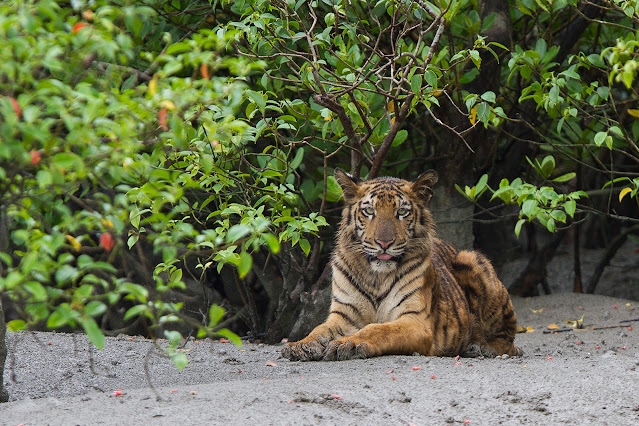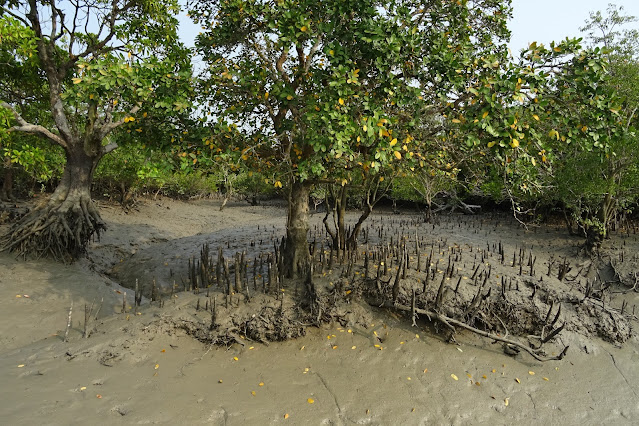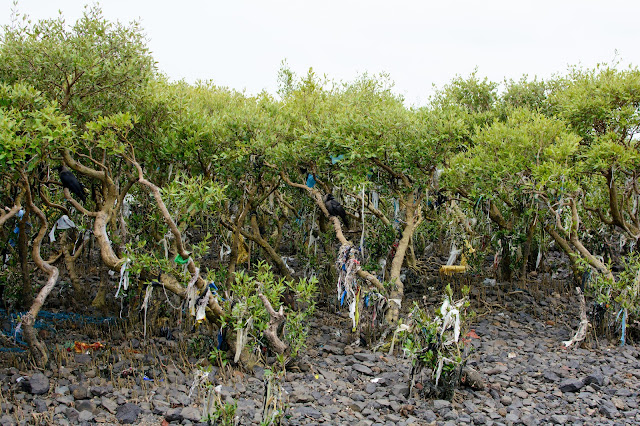 |
| A Bengal tiger in the Sundarbans mangrove forest of West Bengal. Image credit: Soumyajit Nandy via Wikimedia Commons. |
Mangroves are vital to coastal security. Mangrove forests act like a barricade along the coast, protecting inland areas from cyclones, tidal action, etc. This unique vegetation type, adapted to survive in the brackish environment with the help of special adaptations like pneumatophores, also serves as nurseries for aquatic fauna and a number of terrestrial fauna, including the Bengal tiger in the Sundarbans. Fortunately, India is blessed with significant mangrove cover along its coastal areas in several states, with the list below depicting the six states with the most mangrove cover:
1. West Bengal - 42.33%
West Bengal houses a whopping 42.33% of India's total mangrove cover, which is synonymous with the Sundarbans forest of the state. Located at the delta of the Ganga-Brahmaputra-Meghna rivers as they drain into the Bay of Bengal, the Sundarbans mangroves cover a massive area of 2,112 sq. km in the state and also extend further into neighboring Bangladesh. It is also the world's only mangrove area to house the Bengal tiger. The tigers of the Sundarbans are much talked about and the subject of many documentaries, films, stories, and scientific research.
2. Gujarat - 23.54%
 |
| Mangrove forest along the coast of Gujarat. Image credit: https://commons.wikimedia.org/wiki/File:Mangrove_Forest_Sindh.jpg |
Gujarat boasts India's second-highest mangrove cover of 1177.27 sq. km, comprising 23.54% of the country's total. Unlike West Bengal, the state's mangroves are distributed across four coastal areas; the Kachchh region in the Kachchh district has 67.5% of the state's total mangrove cover; the Gulf of Kachchh region with 19.88% of the total cover; and Saurashtra and South Gujarat with 0.48% and 11.87% of the mangrove cover, respectively. For more details, visit here.
3. Andaman And Nicobar Islands - 12.34%
 |
| Mangrove plants in the Andaman and Nicobar Islands. Image credit: Sankara Subramanian via Flickr.com |
This group of islands in India has a mangrove cover of around 616 sq. km, with the Andaman group having the bulk of 613 sq. km and the remainder in the Nicobar. The mangroves of this region cover 7.5% of the land area and are considered the best in India in terms of quality. The mangroves enhance the beauty of the islands and support rich biodiversity.
4. Andhra Pradesh - 8.11%
Although Andhra Pradesh has the fourth highest mangrove cover in India, around 404 sq. km, it constitutes only 0.9% of the state's total forest area. Most of the mangroves are found along the estuaries of the state's major rivers - the Godavari, Krishna, Pennar, and Vamsadhara, as these rivers enter the Bay of Bengal. Small patches of mangroves also occur in some other parts of the state's coast outside these estuary regions.
5. Maharashtra - 6.49%
In 2012, Maharashtra became the country's first state to establish a dedicated wing to conserve the mangroves, and the effort bore fruit, with the state's mangrove cover increasing by 72% by 2022! Six coastal districts of the state, including the city of Mumbai, share this total mangrove cover of 320 sq. km.
6. Odisha - 5.27%
 |
| Bhitarkanika mangroves. Image credit: https://commons.wikimedia.org/wiki/File:Bhitarkanika_Mangroves_Flora_and_Fauna_04.JPG |
Odisha houses a mangrove cover of 258.98 sq. km, of which 80.43 sq. km is dense cover. The Bhitarkanika Sanctuary protects a significant section of this mangrove, while the delta regions of rivers like the Mahanadi, Subarnarekha, and others also have some mangrove cover. Altogether, four Odisha districts with mangroves include - Balasore, Bhadrakh, Jagatsinghpur, and Kendrapada.
Top 10 States In India By Mangrove Cover
- West Bengal - 42.33%
- Gujarat - 23.54%
- Andaman and Nicobar Islands - 12.34%
- Andhra Pradesh - 8.11%
- Maharashtra - 6.49%
- Odisha - 5.27%
- Tamil Nadu - 0.9%
- Goa - 0.52%
- Karnataka - 0.26%
- Kerala - 0.2%
Protecting India's existing mangrove cover and, wherever possible, allowing it to expand further along its historic range is vital to the country's coastal sanctity and biodiversity preservation. Some states have already taken the lead, while others are lagging behind.


No comments:
Post a Comment